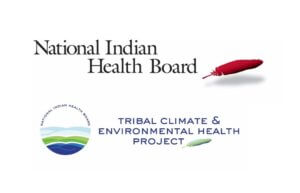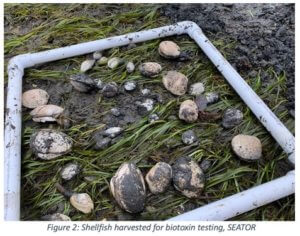Tribal Resiliency is Leading the Way for Climate Change Adaptation… Again


Climate change continues to impact health across the United States in numerous ways. In the last year alone, extreme weather events such as floods, landslides, wildfires, storms, and droughts destroyed people’s homes and livelihoods, damaged nutritious food supplies, and reduced access to safe drinking water. These events played out in tandem with rising temperatures, water and air pollution, and, of course, the COVID-19 pandemic, which had a significant negative impact on Tribal communities. Chronic stresses such as extreme poverty are also being exacerbated by climate change impacts, including reduced access to traditional foods like salmon, shellfish, wild game, and food and medicinal plants which leads to increasing health problems in Native communities. Furthermore, the alteration of fragile ecosystems by government or corporate entities, including destroying habitat for fish and wildlife, restricting drinking water storage, and damaging fertile soils adds to the unjust treatment of Tribal communities and their lands. However, amidst these uninvited changes, Tribes continue to be the example of resiliency in the face of uncontrolled change.
Tribal communities are resource managers with a history of successful and sustained stewardship for their ecosystems that goes back to time immemorial. Even in the face of colonization and genocide, Tribes continued to preserve culture, language, ceremonies, and traditional practices as best they could. This past year, we added a new enemy to the list of threats to our people: COVID-19 Fortunately, Tribes have the established sovereignty to address disease outbreaks. With the historical trauma of genocidal diseases still close to our hearts and minds, Tribal leaders took action to protect our people. Tribal COVID-19 responses can be viewed as potential frameworks for addressing other eminent threats, like climate change.
As a response to these climate-related threats, the Climate Ready Tribes Initiative (CRT), funded by the Centers for Disease Control and Prevention, was developed at the National Indian Health Board with the overall goal of building Tribal capacity related to climate health. This work includes increasing Tribal capacity to recognize and respond to climate threats, by providing support to take action, and working with Tribes to develop climate change responses that are localized and effective for their unique environment. Other activities to support this work includes hosting a Climate and Health Learning Community to share resources and connect individuals and organizations through information sharing.


Two CRT sub-awardees, the Lummi Nation in Washington State and the Sitka Tribe of Alaska, are both working with similar ecosystems to adapt to water pollutants in their coastal lands. With the provided funding, the Lummi Natural Resource Department (LNR) has been able to respond to the increased risk of Harmful Algae Blooms (HABs) that are poisoning local shellfish—an important First Food for the Lummi people. In recent years, particular levels of biotoxins have increased and new biotoxin types have emerged, which leads to longer beach closures and limited harvesting times. As the climate warms, HABs are expected to increase, last longer, and cause more damage to marine wildlife and subsistence resources for AI/AN communities. This past year, the LNR has built the capacity to respond to this marine threat by developing culturally relevant educational materials for the Lummi Nation and partnerships with local networks. While the risks to First Foods are not minimized, the Lummi Nation hopes to see less occurrences of toxic shellfish poisoning among their people.


Similarly, the Sitka Tribe of Alaska is working to address HABs in the context of shellfish poisoning. Due to the constant state of increased biotoxin risk in Southeast Alaska waters, the State of Alaska recommends that people purchase wild shellfish instead of harvesting. However, that is not a viable option in most coastal communities where people are reliant on First Foods as their subsistence. The Sitka Tribe of Alaska has taken the initiative to gather the fifteen Southeast Alaska Tribes to better understand the risk associated with shellfish harvesting. This network, called the Southeast Alaska Tribal Ocean Research (SEATOR), includes partners located as far north as Yakutat all the way south to Metlakatla, two villages that are separated by nearly 18,000 miles of coastline. SEATOR partners are establishing a standardized system for testing shellfish, and their findings have confirmed what Alaska Natives have known for years—shellfish cannot be harvested in the summer months. However, these findings have also confirmed that shellfish are not safe to consume during all months of the year. Now, SEATOR is working to working to address these findings by increased education and partnership.
The third CRT awardee for this year is taking a different approach to addressing climate change that is applicable to their unique environment and circumstances. In response to climate-related emotional and cultural stress, the Pala Band of Mission Indians in Southwest California has produced a psychosocial resilience framework that Pala and other Tribes can use to tailor adaptation responses sensitive to the unique needs and values of individual communities. For example, in Pala, climate change affects the health of oak trees, making them more susceptible to drought stress and injury from invasive pests. This affects the production of acorns, which are a traditional subsistence food that is still important for special occasions. When people cannot collect acorns to make wiiwish, or acorn mush, that has an impact on psychosocial wellbeing and can cause stress and grief about the potential loss of important cultural traditions and associated values.
These are only a few examples of how Tribes have been addressing climate change as a form of community and ecological resiliency. It is important to recognize that many Tribes are working with limited resources to address these impacts on their communities, but they are often the ones leading the response to climate threats. AI/AN people have lived here for thousands of years, and we will continue to be here fighting for the health of our land and peoples for thousands more.
Mattie Curry, MPH, is the Public Health Policy and Programs Coordinator at the National Indian Health Board (NIHB). NIHB and Climate for Health are partnering throughout November for National Native American Heritage Month to amplify Tribal leadership on climate solutions. You can learn more about NIHB’s Climate Ready Tribes Program here.